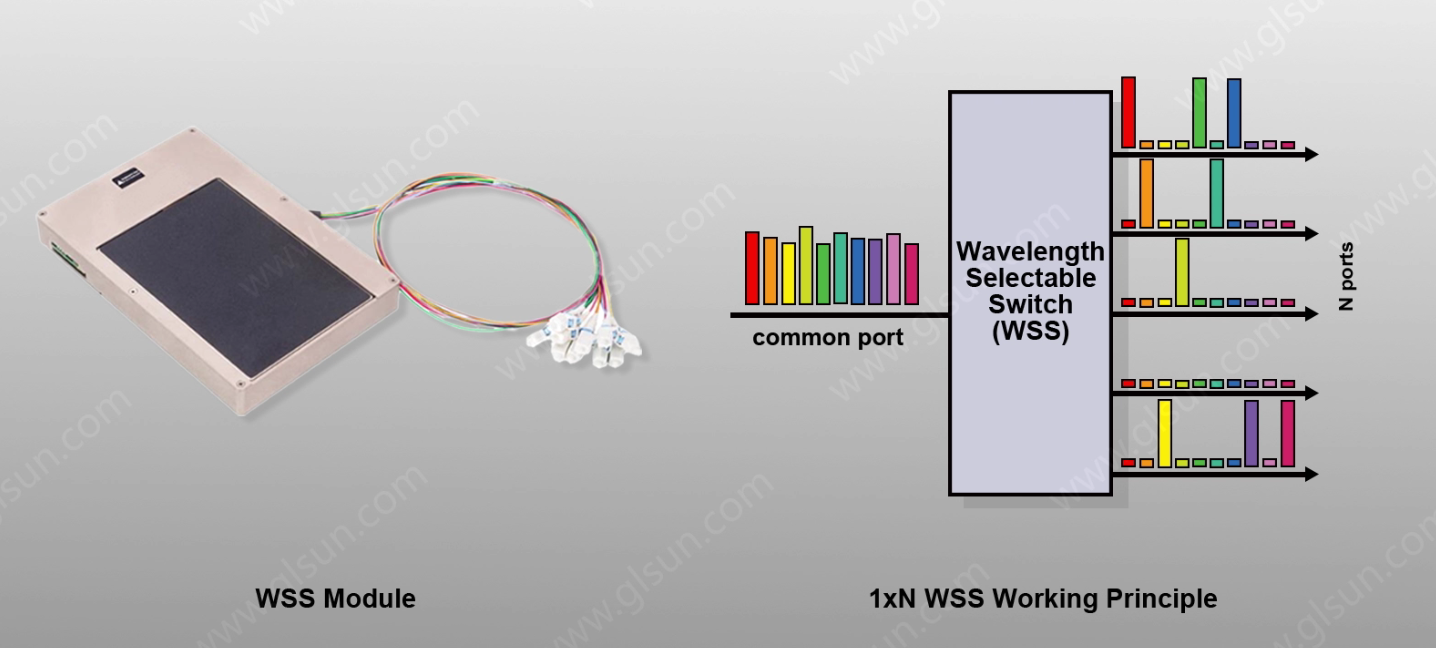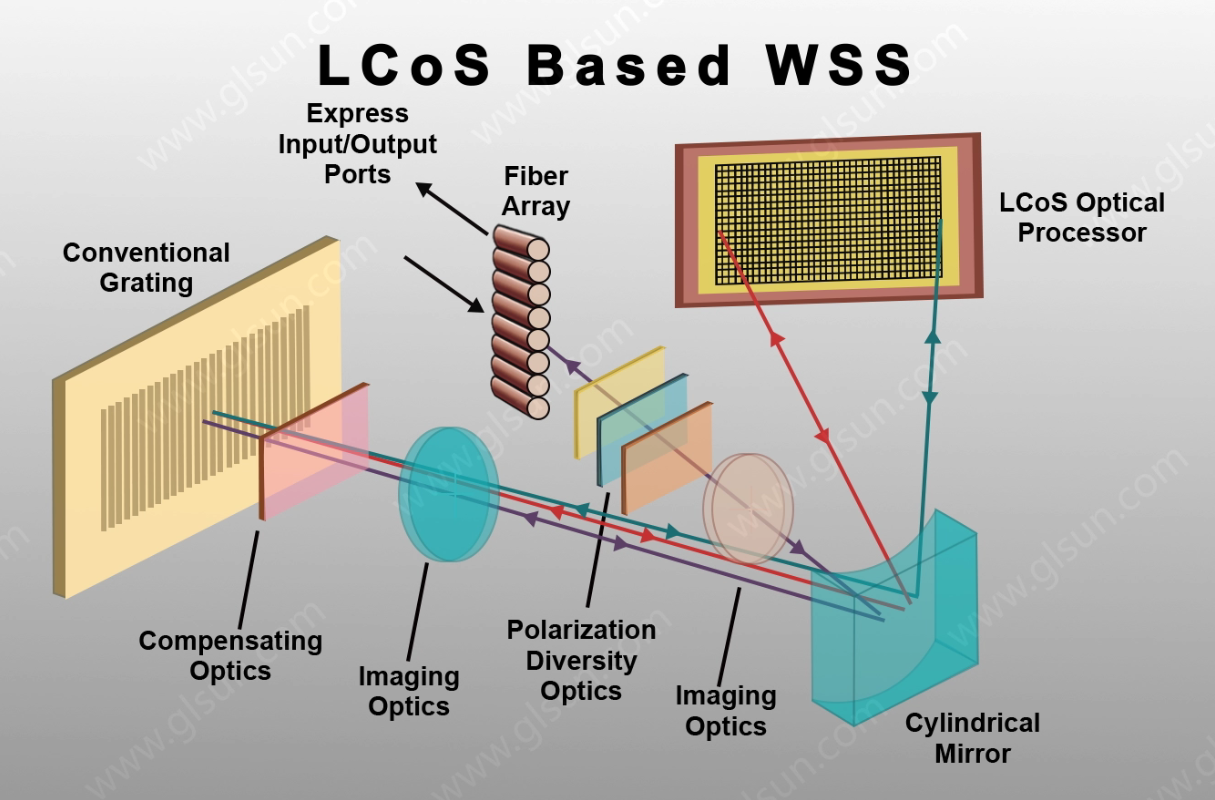How Does a Wavelength Selective Switch (WSS) Work?
2025-04-03
In modern optical communication networks, the ability to dynamically route optical signals with high precision and minimal signal degradation is critical. A key enabling technology in reconfigurable optical add-drop multiplexers (ROADMs) is the Wavelength Selective Switch (WSS). This device plays a vital role in managing wavelength channels efficiently in dense wavelength-division multiplexing (DWDM) systems.
A Wavelength Selective Switch (WSS) is an advanced optical switching device that selectively routes different wavelength channels from an input fiber to one or multiple output fibers. Unlike traditional fixed optical filters or static optical splitters, a WSS provides dynamic configurability, allowing network operators to adjust channel assignments based on demand.
WSS is a crucial component in flexible-grid ROADMs, enabling wavelength grooming, contention resolution, and network reconfiguration without requiring manual intervention.

Core Working Principle of WSS
The operation of a Wavelength Selective Switch is based on the ability to demultiplex, manipulate, and remultiplex optical signals in a controlled manner. The core working mechanism involves the following key steps:
1). Optical Signal Demultiplexing
- Incoming DWDM signals, carrying multiple wavelength channels, enter the WSS through an input fiber.
- A diffraction grating or prism separates the composite optical signal into its constituent wavelengths, dispersing them spatially.
2). Wavelength Channel Selection and Routing
- The separated wavelength components are directed onto a spatial light modulator (SLM), such as Liquid Crystal on Silicon (LCoS) or Micro-Electro-Mechanical Systems (MEMS) mirrors.
- The SLM dynamically adjusts the phase or angle of each wavelength, determining the desired output path for each channel.
3). Optical Signal Remultiplexing
- The routed wavelengths are then recombined using another optical element, such as a second diffraction grating or a lens system.
- The reconfigured optical signals are directed into the appropriate output fibers, completing the switching process.
The WSS can be configured to perform wavelength blocking, splitting, and routing with flexible control over bandwidth allocation, making it indispensable in modern optical networks.
Key Technologies in WSS
There are several key technologies that enable the functionality of WSS devices:
1). Liquid Crystal on Silicon (LCoS)
- LCoS-based WSS utilizes a high-resolution phase-modulating spatial light modulator.
- The liquid crystal elements alter the phase of incident light, enabling precise diffraction-based routing.
- This technology supports flexible-grid optical networks by dynamically adjusting channel spacing and bandwidth.

2). Micro-Electro-Mechanical Systems (MEMS)
- MEMS-based WSS employs micro-mirrors that tilt to redirect wavelength channels to the appropriate output ports.
- Offers high switching speed and stability but is generally limited to fixed-grid channel spacing.
3). Free-Space Optics & Diffraction Elements
- Optical gratings or prisms are used to disperse and recombine optical signals.
- Lens systems focus and direct the separated wavelengths with minimal insertion loss.
Each of these technologies plays a critical role in determining the switching speed, insertion loss, and configurability of a WSS.
Advantages of WSS in Optical Networks
The adoption of Wavelength Selective Switches in optical communication networks provides several advantages:
1). Flexibility in Wavelength Routing
- WSS allows for dynamic wavelength reconfiguration, enabling more efficient use of network resources.
2). Support for Flexible Grid Networks
- Unlike traditional fixed-grid ROADMs, WSS can accommodate variable channel spacing, supporting high-speed coherent transmission.
3). Reduced Network Complexity and Cost
- A single WSS can replace multiple static wavelength routers and fixed optical filters, reducing capital and operational expenditures.
4). High Optical Signal Integrity
- Advanced WSS implementations minimize insertion loss and optical impairments, preserving signal quality across long-distance transmission.
Applications of Wavelength Selective Switches
WSS technology is widely deployed in various optical networking scenarios:
1). Reconfigurable Optical Add-Drop Multiplexers (ROADMs)
- Enables dynamic wavelength switching in multi-degree optical mesh networks.
2). Optical Cross-Connects (OXCs)
- Used in high-capacity data center interconnects and core backbone networks.
3). 5G Transport Networks
- Supports efficient wavelength allocation in high-speed, low-latency 5G backhaul networks.
4). Data Center Interconnection (DCI)
- Enhances optical switching capabilities in hyperscale cloud infrastructure.
The Wavelength Selective Switch (WSS) is a cornerstone technology in next-generation optical networks, enabling flexible, high-capacity, and dynamically reconfigurable wavelength routing. By leveraging LCoS and MEMS-based technologies, WSS provides superior performance, supporting both fixed-grid and flexible-grid optical networks.
As demand for high-speed broadband and cloud-based services grows, the role of WSS in optimizing optical networks will continue to expand, making it an essential component of future intelligent, software-defined optical infrastructures.







